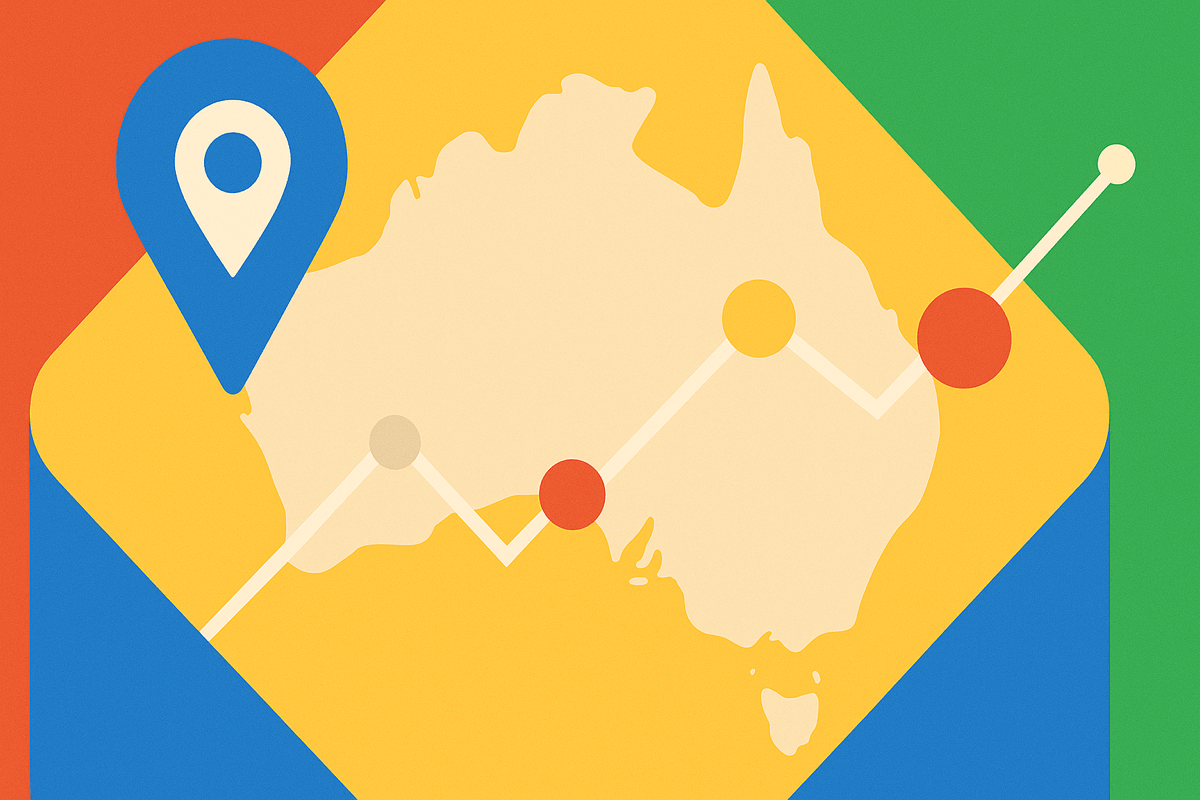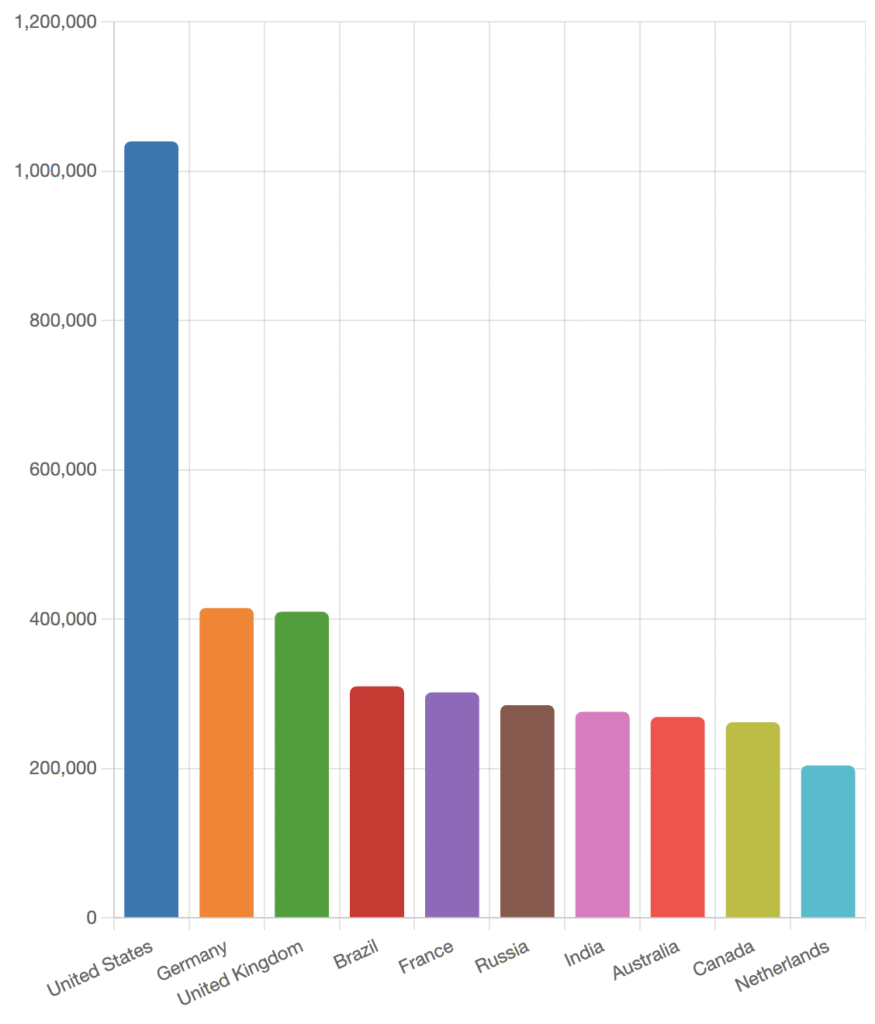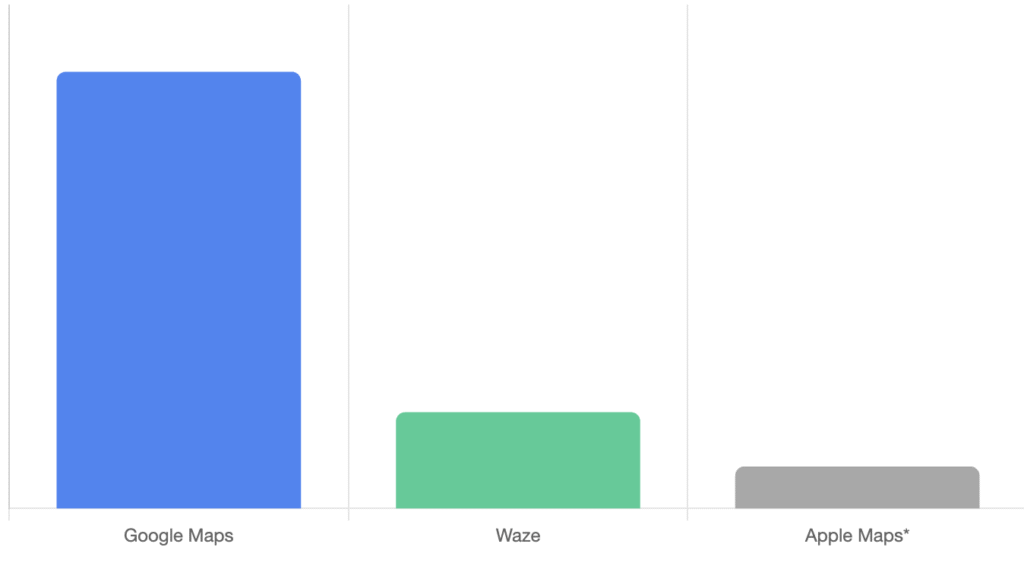Google Maps Statistics in Australia: Total Domination (2025)

Last Updated on 19 August 2025 by Dorian Menard
The average Australian Google Maps user now spends more than 150 minutes per month on the app. That’s not just a sign of digital convenience — it’s a window into how deeply Google Maps is embedded in the daily lives, business decisions, and local economies of Australia.
From its origins in a Sydney apartment to its current status as the country’s most relied-upon navigation and discovery tool, Google Maps has become an essential part of the Australian digital landscape.
This guide unpacks the hard numbers behind that dominance, revealing how Australians use Google Maps, how it shapes business visibility, and why it remains unrivalled in the local market.
Google Maps in Australia: The Big Picture
Google Maps’ journey in Australia began in Sydney, where the foundational technology was developed by Where 2 Technologies before being acquired by Google in 2004. Today, this Sydney-born innovation serves over 2 billion global monthly users worldwide, with Australia representing a significant portion of that user base.
The platform’s penetration in Australia is remarkable. With 97.1% internet penetration across the country — representing 26.1 million users in 2025 — Google Maps has access to virtually every connected Australian. This digital saturation provides the foundation for the platform’s dominance in local search and navigation.
Perhaps most telling is the integration depth: over 269,000 Australian websites embed Google Maps, ranking Australia 8th globally for Maps integration. This statistic reveals how deeply the platform is woven into the Australian digital ecosystem, from small business websites to major enterprise applications.

The global scale of Google Maps is staggering — with over 10 billion downloads on Google Play and more than 150 million local businesses listed globally — but Australia’s adoption patterns show unique characteristics that set it apart from other markets.
Usage Patterns: How Australians Use Google Maps
The headline statistic — 152 minutes per month per user — only tells part of the story. When broken down, this translates to approximately 50 sessions per month at an average of 3 minutes per session, indicating frequent, purposeful use rather than extended browsing.
Australia records 2.61 million weekly active Google Maps users as of Q3 2024, a figure that demonstrates consistent engagement across the platform. This user base represents a significant portion of Australia’s adult population, highlighting the platform’s role as essential infrastructure rather than optional convenience.
Mobile usage dominates the landscape, with the vast majority of sessions occurring on smartphones. However, desktop usage remains relevant for trip planning and business research, particularly for longer journeys or detailed location analysis.
The most common use cases for Australian users include:
- Navigation and route planning (primary use case)
- Business discovery and reviews (40% of Google searches have local intent)
- Real-time traffic and incident reporting
- Crisis information (bushfire alerts, air quality monitoring)
- Sustainable transport options (eco-friendly routes, petrol price comparison)
Google Maps vs. The Competition
In the Australian market, Google Maps faces competition primarily from Waze and Apple Maps, but the data reveals a clear hierarchy. While Waze leads in app downloads, Google Maps maintains significantly higher active usage rates, with 2.61 million weekly active users compared to Waze’s 558,000.
This disparity between downloads and active usage suggests that while Australians may experiment with alternative navigation apps, they consistently return to Google Maps for their primary navigation needs. The platform’s 97% accuracy in ETA predictions contributes to this user loyalty, providing reliability that competitors struggle to match.

Key Market Intelligence:
- Google Maps Absolute Dominance: With 2.6+ million weekly active users, Google Maps commands an overwhelming 82% market share in Australia’s navigation app space.
- Waze’s Niche Position: At ~573,000 weekly users, Waze maintains a solid but secondary position—roughly 18% of Google Maps’ usage.
- Apple Maps’ Notable Absence: Despite iOS holding significant market share in Australia, Apple Maps data isn’t even published by analytics firms—a telling indicator of underperformance.
Apple Maps, despite being pre-installed on iOS devices, lags considerably behind both Google Maps and Waze in the Australian market. The platform’s limited local business data and less comprehensive feature set have hindered its adoption among Australian users.
The competitive landscape reveals Google’s strategic advantage: while Waze focuses primarily on real-time traffic and community-driven updates, Google Maps offers a comprehensive ecosystem combining navigation, business discovery, reviews, and local search functionality.
Business Integration and Local SEO
Google Maps serves as the backbone of local SEO and business discovery in Australia. With 40% of Google searches having local intent, the platform directly influences how Australians find and interact with local businesses.
The 269,000+ Australian websites embedding Google Maps demonstrate the platform’s critical role in business websites. From small local services to major retail chains, businesses recognise that Maps integration is essential for customer convenience and credibility.
Maintaining strong online reputations through Google Business Profile listings has become crucial for local success. The platform’s review system significantly impacts consumer behaviour, with businesses commanding a 22% price premium when they maintain strong online reputations through positive reviews and high ratings.
Local SEO investment in Australia is projected to reach $1.5 billion in 2025, with Google Maps optimisation representing a significant portion of this spend. Businesses understand that visibility on Google Maps directly correlates with foot traffic and online conversions.
The platform’s influence extends beyond simple listings. Features like business hours, contact information, photos, and customer reviews create comprehensive business profiles that serve as digital storefronts for local enterprises.
Read our report on the state of SEO and marketing in Australia.
The Most-Reviewed and Searched Locations in Australia
Analysis of review data reveals fascinating insights into Australian consumer behaviour and preferences. The most-reviewed restaurant in Australia as of 2025 is Dosa Hut in Harris Park, NSW, with an impressive 14,400 reviews and a 4.61-star rating.
This statistic highlights several trends:
- Multicultural dining venues dominate the most-reviewed locations
- Indian restaurants feature prominently in high-review counts
- Suburban locations can achieve significant review volumes, not just city centres
The prevalence of Indian and multicultural venues in top review counts reflects Australia’s diverse population and dining preferences. These establishments often serve as community hubs, generating higher engagement and review activity.
Tourist attractions and major retail centres also feature prominently in review volumes, with locations like Sydney Opera House, Melbourne’s Queen Victoria Market, and major shopping centres maintaining thousands of reviews each.
Feature Adoption and Technical Innovations
Google Maps’ feature set continues to evolve, with Australians adopting new capabilities at varying rates. Real-time traffic updates remain the most utilised advanced feature, with the platform processing over 1 billion kilometres driven daily globally.
Augmented Reality navigation (Live View) has gained traction in major Australian cities, particularly useful for pedestrian navigation in complex urban environments like Sydney’s CBD and Melbourne’s laneways.
Crisis response features have become particularly relevant in Australia, with the platform providing real-time bushfire alerts, air quality monitoring, and emergency service information. These features demonstrate Google Maps’ evolution from simple navigation to comprehensive local information hub.
Eco-friendly routing reflects growing environmental consciousness, with the platform calculating fuel-efficient routes and providing petrol price comparisons — features particularly valuable given Australia’s vast distances and fuel costs.
The Local Guides community contributes significantly to the platform’s accuracy, with over 120 million contributors globally providing photos, reviews, and location updates that enhance the Australian user experience.
Google Maps’ Role in the Australian Digital Economy
Google Maps functions as critical infrastructure for Australia’s digital economy. The platform’s API powers over 5 million apps and websites globally, with Australian businesses representing a significant portion of this integration.
The economic impact extends beyond direct usage. Businesses report that Google Maps visibility directly influences customer acquisition, with strong Maps presence correlating with increased foot traffic and online engagement.
Voice search integration has become increasingly important, with 33% of Australians using voice search daily. This trend particularly benefits Google Maps, as location-based queries naturally suit voice interaction patterns.
Question-based searches represent 8% of local queries, indicating how users interact with the platform conversationally rather than through traditional keyword searches. This evolution reflects changing search behaviours and the platform’s AI-driven improvements.
The platform’s influence on purchasing decisions is substantial, with local search directly impacting consumer behaviour and business discovery patterns across Australia.
Demographics and Behavioural Insights
While comprehensive demographic breakdowns remain proprietary, available data suggests Google Maps usage spans all age groups and regions. Mobile-first behaviour dominates, with smartphone usage accounting for the vast majority of sessions.
Voice search adoption varies by demographic, with younger users more likely to use voice commands for navigation and location queries. This trend has implications for how businesses optimise their Google Maps presence.
Regional usage patterns show higher per-capita usage in major metropolitan areas, but significant adoption across regional Australia reflects the platform’s utility for longer-distance travel and local business discovery in smaller communities.
The platform serves different purposes across user segments:
- Commuters rely on real-time traffic updates and route optimisation
- Tourists utilise reviews, photos, and discovery features
- Business owners focus on listing management and customer engagement
- Delivery drivers depend on accuracy and real-time updates
Google Maps in Crisis and Sustainability
Australia’s challenging environment has positioned Google Maps as an essential crisis response tool. The platform’s bushfire monitoring capabilities provide real-time alerts and evacuation route information, proving invaluable during Australia’s fire seasons.
Air quality monitoring integration helps users make informed decisions about outdoor activities, particularly relevant in major cities experiencing pollution events or during bushfire seasons.
Sustainable transport features align with growing environmental consciousness, offering eco-friendly route options and supporting Australia’s transition to more sustainable transportation patterns.
The platform’s crisis response capabilities extend beyond natural disasters, providing traffic incident reporting, road closure updates, and emergency service notifications that enhance public safety and mobility.
The Future of Google Maps in Australia
AI integration through Gemini and other Google technologies promises to enhance the user experience significantly. AI Overviews will provide more contextual information about locations, while improved natural language processing will make voice interactions more intuitive.
Predictive features will anticipate user needs based on historical behaviour and real-time conditions, potentially suggesting optimal departure times, alternative routes, or relevant local businesses.
Augmented reality expansion will likely extend beyond navigation to include contextual information overlays, business promotions, and enhanced discovery features.
The competitive landscape will continue evolving, but Google’s ecosystem advantages — integration with Search, Android, and other Google services — provide significant barriers to competition.
Key Takeaways and Actionable Insights
The data reveals several critical insights:
- Google Maps is essential infrastructure — with 152 minutes monthly usage per user, it’s beyond optional convenience
- Business visibility on Maps directly impacts revenue — the 22% price premium for good reputations proves ROI
- Local search dominates — 40% of Google searches have local intent, making Maps crucial for business discovery
- Mobile-first is reality — desktop usage exists but mobile dominates actual usage patterns
- Integration depth matters — 269,000+ Australian websites embed Maps, showing ecosystem importance
- Competition exists but doesn’t threaten dominance — Waze downloads don’t translate to active usage
- Crisis response has become essential — bushfire alerts and air quality monitoring serve public safety
- AI and voice search are changing interaction patterns — 33% daily voice search usage indicates evolving user behaviour
For businesses, the implications are clear: Google Maps optimisation isn’t optional marketing — it’s essential infrastructure for customer acquisition and retention.
Full Source List and Further Reading
- Google Blog AU – 20 Years of Maps
https://blog.google/intl/en-au/products/explore-get-answers/20-years-of-maps-australia/ - 9to5Google – Google Maps now has over 2 billion monthly users
https://9to5google.com/2024/10/29/google-maps-2-billion/ - DataReportal – Digital 2025: Australia
https://datareportal.com/reports/digital-2025-australia - SensorTower – Top 5 Navigation and Maps Apps in Australia Q3 2024
https://sensortower.com/blog/2024-q3-unified-top-5-navigation%20and%20maps-units-au-63e3a85de1714cfff14cf6c0 - Red Search – Google Maps Statistics Australia (2025)
https://www.redsearch.com.au/resources/google-maps-statistics-australia/ - LoopEx Digital – Essential Google Maps Statistics 2025
https://www.loopexdigital.com/blog/google-maps-statistics - Center AI – Google Maps Statistics and Interesting Facts
https://center.ai/blog/google-maps-statistics-and-interesting-facts/ - OnTheMap – 29 Google Maps Statistics: Verified and Updated For 2025
https://www.onthemap.com/blog/google-maps-statistics/ - SQ Magazine – Google Maps Statistics 2025
https://sqmagazine.co.uk/google-maps-statistics/ - ElectroIQ – Google Maps Statistics And Facts (2025)
https://electroiq.com/stats/google-maps-statistics/
Additional Research Sources:
- BuiltWith – Google Maps Integration Data
- Google Official Blog and Press Releases
- Australian Bureau of Statistics Digital Usage Reports
- Local SEO industry reports and surveys
- Mobile app analytics platforms
- Digital marketing research publications
Appendix: Raw Data Tables and Charts
Key Statistics Summary:
- Weekly Active Users (Australia): 2.61 million
- Monthly Usage per User: 152 minutes
- Australian Websites with Maps Integration: 269,000+
- Global Monthly Users: 2+ billion
- ETA Accuracy: 97%
- Local Search Intent: 40% of Google searches
- Voice Search Daily Users: 33% of Australians
- Question-Based Local Queries: 8%
- Internet Penetration Australia: 97.1%
- Most-Reviewed Restaurant: Dosa Hut, Harris Park (14.4K reviews)
More internet statistics for Australia.
Conclusion
Google Maps is not just a navigation tool — it’s a digital backbone for how Australians move, search, and do business. With over 2.6 million weekly active users locally and more than 150 minutes spent per user each month, its influence is unrivalled.
The platform’s integration into daily routines, business discovery, and crisis response cements its place at the centre of Australian digital life. For businesses, marketers, and anyone tracking the evolution of local search, the message is clear: ignore Google Maps at your peril. The data proves it’s not just a map — it’s the map.